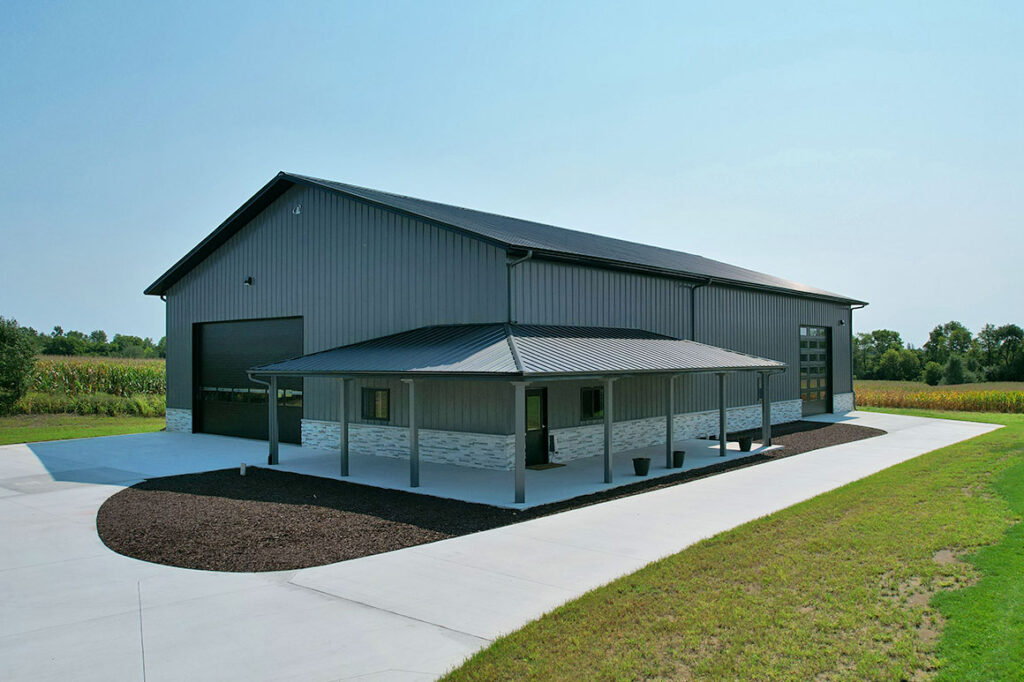Across the Flint Hills and throughout Central Kansas, many property owners look at their existing pole barns and wonder if they could be converted into comfortable barndominiums. It’s a practical question. Post-frame buildings are common across Kansas for their strength, affordability, and versatility. But turning a working barn into a Kansas home takes more than new finishes—it requires structural evaluation, design work, and attention to local codes.
Here’s what to know if you’re considering converting a pole barn to a barndominium in Kansas.
Understanding Kansas Pole Barn Construction
Most Kansas pole barns were built for agricultural or storage purposes, not residential living. From Council Grove to Manhattan and Alta Vista, these buildings were designed to withstand strong Kansas winds, but not necessarily to manage insulation, plumbing, or long-term heating and cooling.
Typical features of a traditional Kansas post-frame building include wide post spacing (often 8–12 feet on center), trusses designed for wind and snow but not ceiling loads, ventilated walls and ridge caps for air flow rather than insulation, and minimal concrete or shallow slabs without frost protection.
These designs perform well for machine sheds or hay storage, but residential conversions require additional engineering and upgrades.
What It Takes to Convert a Pole Barn to a Barndominium in Kansas
Turning a Kansas pole barn into a barndominium means upgrading nearly every part of the structure to meet residential building codes. That process often includes installing or reinforcing a frost-protected concrete slab suitable for plumbing, adding insulation and vapor barriers to manage Kansas temperature swings, reinforcing trusses to support drywall and interior finishes, and adding modern plumbing, HVAC, and electrical systems.
Many Flint Hills barndominium conversions also involve new siding or roof materials to improve energy efficiency and long-term durability. A licensed Kansas post-frame builder can help determine if your barn’s structure is suitable for this level of renovation.
Kansas Climate and Soil Conditions Matter
The Kansas climate plays a major role in determining whether a conversion will hold up over time. The combination of strong southwest winds, freeze-thaw cycles, and heavy spring rains can create challenges for barns not originally designed as airtight, insulated structures.
In areas like Manhattan, Wamego, and Topeka, expansive clay soils can cause slab movement if a building wasn’t engineered with frost footings or piers. For a Kansas barndominium, the foundation must handle these soil shifts while maintaining tight seals for heating and cooling efficiency.
When Conversion Works for Kansas Homeowners
A Kansas pole barn conversion can be successful when the structure is newer and in good condition, the posts and trusses are properly treated and anchored, utilities and road access are already available, and the site drains well with room for additions.
In these situations, keeping the existing frame can preserve resources and honor the building’s history while creating a functional Kansas barndominium home.
When Building a New Kansas Barndominium Is More Practical
For many property owners in the Flint Hills and Central Kansas, building new is often more cost-effective and efficient than a retrofit. A new post-frame barndominium in Kansas can be designed for modern energy codes, local soil conditions, and the way you plan to live—without compromising layout or performance.
Starting fresh allows for engineered concrete foundations, high R-value insulation systems, custom layouts with clear spans and vaulted ceilings, and energy-efficient building envelopes designed for Kansas weather.
While it might cost more upfront, a new Kansas barndominium typically performs better over time and requires less maintenance.
The Kansas Bottom Line
Yes, you can convert a pole barn into a barndominium in Kansas—but success depends on structure, soil, and long-term goals. Many barns across the Flint Hills region were built to handle cattle, hay, and equipment, not kitchens, bedrooms, and HVAC systems.
If your goal is a lasting, comfortable home that performs well in Kansas weather, start with a professional evaluation from a local Kansas post-frame builder who understands how our soils, winds, and codes work together.
With the right planning and expertise, a barndominium can be a beautiful and efficient way to live the Kansas life—built to stand strong on the same land that inspired it.




